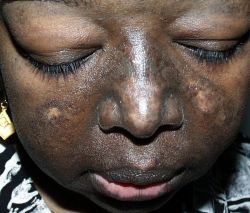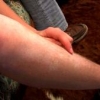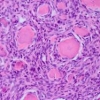Differenze tra gli autoanticorpi IgG e IgM nei pazienti con lupus discoide e sistemico
 I pazienti affetti da lupus eritematoso sistemico (LES) con lupus eritematoso discoide (DLE) sono stati segnalati per avere una malattia più lieve. Per verificare questa osservazione, abbiamo usato i saggi sandwich contenenti 98 autoantigeni al fine di confrontare i profili autoanticorpali di soggetti affetti da LES senza DLE (DLE-SLE+) (N = 9), soggetti affetti da SLE con DLE (DLE+SLE+) (N = 10), soggetti DLE senza SLE (DLE+SLE-) (N = 11), e controlli sani (N = 11).
I pazienti affetti da lupus eritematoso sistemico (LES) con lupus eritematoso discoide (DLE) sono stati segnalati per avere una malattia più lieve. Per verificare questa osservazione, abbiamo usato i saggi sandwich contenenti 98 autoantigeni al fine di confrontare i profili autoanticorpali di soggetti affetti da LES senza DLE (DLE-SLE+) (N = 9), soggetti affetti da SLE con DLE (DLE+SLE+) (N = 10), soggetti DLE senza SLE (DLE+SLE-) (N = 11), e controlli sani (N = 11).
Abbiamo convalidato autoanticorpi differentemente espressi mediante saggi immunologici nei DLE-SLE+ (N = 18), DLE+SLE+ (N = 17), DLE+SLE- (N = 23) e nei soggetti sani (N = 22). I saggi hanno mostrato 15 autoanticorpi IgG (10 contro antigeni nucleari) e 4 autoanticorpi IgM che sono stati espressi in modo differente (q-valore <0.05). I soggetti DLE-SLE+ avevano autoanticorpi IgG più alti contro il DNA a doppia elica (dsDNA), DNA a singolo filamento (ssDNA), RNA a doppio filamento (dsRNA), istoni H2A e H2B, e SS-A (52 kDa) rispetto a tutti gli altri gruppi compresi i soggetti DLE+SLE+ (P <0.05). Gli immunodosaggi che misuravano gli autoanticorpi IgG anti-dsDNA, ssDNA, e -SS-A (52 kDa) hanno mostrato un andamento simile (P <0.05). I soggetti sani e DLE+SLE- hanno espresso autoanticorpi IgM più alti contro alfa beta cristallina, lipopolisaccaride, proteine da shock termico affini 70, e desmogleina-3 rispetto ai soggetti DLE+SLE+ e DLE-SLE+.
I rapporti tra gli autoanticorpi IgG:IgM diretti contro gli antigeni nucleari si sono progressivamente alzati nel passaggio dai soggetti sani fino a quelli DLE-LES+. In conclusione, un numero più basso di autoanticorpi IgG contro gli antigeni nucleari nei soggetti DLE+SLE+ rispetto a quelli DLE-SLE+ suggerisce come DLE sia alla base di una gravità più bassa della malattia. Livelli più alti di autoanticorpi IgM contro gli antigeni selezionati, nei soggetti sani e in quelli DLE+SLE-, potrebbero non essere patogeni.
Storia della pubblicazione:
Titolo: IgG and IgM Autoantibody Differences in Discoid and Systemic Lupus Patients
Rivista: Journal of Investigative Dermatology (2012) 132, 2770–2779; doi:10.1038/jid.2012.207
Autori: Benjamin F Chong, Lin-chiang Tseng, Thomas Lee, Rebecca Vasquez, Quan Z Li, Song Zhang, David R Karp, Nancy J Olsen and Chandra Mohan
Affiliazioni: Department of Dermatology, University of Texas Southwestern Medical Center, Dallas, Texas, USA
Department of Internal Medicine, University of Texas Southwestern Medical Center, Dallas, Texas, USA
Department of Clinical Sciences, University of Texas Southwestern Medical Center, Dallas, Texas, USA
Department of Internal Medicine, Penn State Milton S. Hershey Medical Center, Hershey, Pennsylvania, USA
Abstract:
Systemic lupus erythematosus (SLE) patients with discoid lupus erythematosus (DLE) were reported to have milder disease. To test this observation, we used sandwich arrays containing 98 autoantigens to compare autoantibody profiles of SLE subjects without DLE (DLE−SLE+) (N=9), SLE subjects with DLE (DLE+SLE+) (N=10), DLE subjects without SLE (DLE+SLE−) (N=11), and healthy controls (N=11). We validated differentially expressed autoantibodies using immunoassays in DLE−SLE+ (N=18), DLE+SLE+ (N=17), DLE+SLE− (N=23), and healthy subjects (N=22). Arrays showed 15 IgG autoantibodies (10 against nuclear antigens) and 4 IgM autoantibodies that were differentially expressed (q-value<0.05). DLE−SLE+ subjects had higher IgG autoantibodies against double-stranded DNA (dsDNA), single-stranded DNA (ssDNA), double-stranded RNA (dsRNA), histone H2A and H2B, and SS-A (52 kDa) compared with all other groups including DLE+SLE+ subjects (P<0.05). Immunoassays measuring anti-dsDNA, -ssDNA, and -SS-A (52 kDa) IgG autoantibodies showed similar trends (P<0.05). Healthy and DLE+SLE− subjects expressed higher IgM autoantibodies against alpha beta crystallin, lipopolysaccharide, heat-shock cognate 70, and desmoglein-3 compared with DLE+SLE+ and DLE−SLE+ subjects. IgG:IgM ratios of autoantibodies against nuclear antigens progressively rose from healthy to DLE−SLE+ subjects. In conclusion, lower IgG autoantibodies against nuclear antigens in DLE+SLE+ versus DLE−SLE+ subjects suggest that DLE indicates lower disease severity. Higher IgM autoantibodies against selected antigens in healthy and DLE+SLE− subjects may be nonpathogenic.





